Spring Veggie Salad with Pickled Cherries and Tahini Dressing & Food Citizenship
Tactical tips for how we can push for change beyond our colorful plates!
Colorful chefs - happy Thursday 🧡
This is where we cook easy, delicious, saucy, colorful meals made from whole, unprocessed foods, and we make it fun, easy, and learn important stuff about metabolic health and home cooking while doing it.
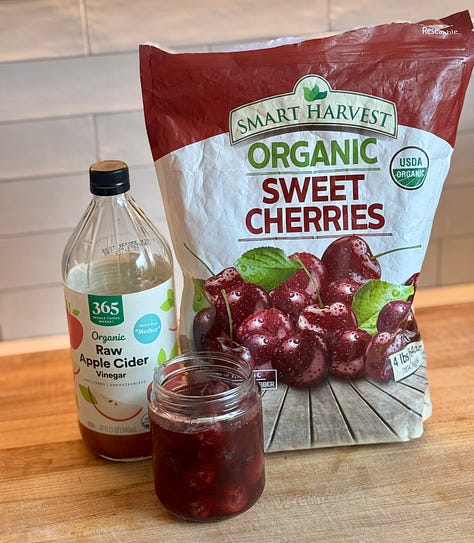
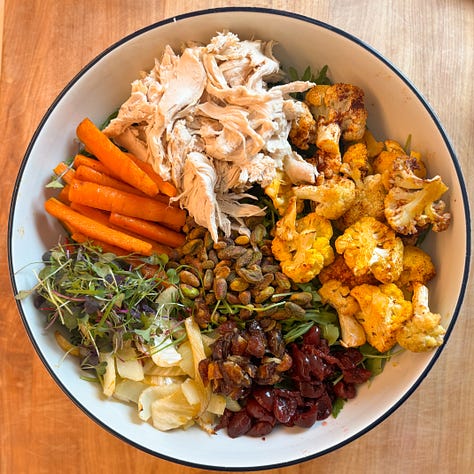
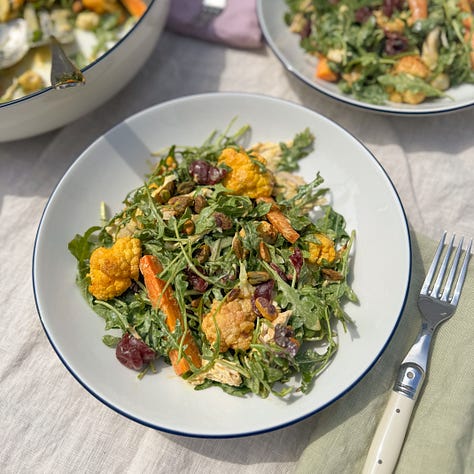
Spring Veggie Salad with Pickled Cherries and Tahini Dressing: In my poll last week, you asked for easy lunches and quick but flavorful dinners — and so that’s what I’ve got planned for the next few weeks! This week is a Spring Veggie Salad with Pickled Cherries and Tahini Dressing, inspired by a winery in Carmel I went to a few weekends ago. Alex and I have eaten it no less than 6 times now, and I still love it. Read on!
How The World Eats: This week, I’ve been reflecting on how little we really know about the full journey of the food in our fridges — and how much influence we actually have to shape that journey. I’ve been listening to How the World Eats by Julian Baggini, which explores the complexity of our global food system and the need to move beyond one-size-fits-all solutions. One idea that’s really stuck with me: we’re not just consumers, we’re citizens — and that means we can push for change far beyond what’s on our colorful plates! More below.
12 Amazing Women In Health Share the Hormone Truths Every Woman Should Know: I’ve been on a journey to balance and support my hormones over the last few years, and these tips are truly gold. I’m honored to be included in this piece by Karina Baloleanu, and you won’t be surprised my tip is all about tactical things to improve your blood sugar balance! Read here.
I’ve been thinking a lot about how little we really know about the foods in our fridges and cupboards. Of course, I try to understand a brand’s sourcing and from local SoCal farms — but that’s certainly not the case for everything in my fridge or pantry. So, I’m loving listening to the book How The World Eats by Julian Baggini because he explores the intricate web of our global food system. I first started by listening to Julian on Mark Bittman’s podcast , which is a great overview if you just want to dabble, but since then I’ve been diving into the entire book.
He articulates the complexity of the food system challenge in a way I found both reassuring and discouraging at the same time 🤣
“There is no shortage of people offering solutions about our food system, unfortunately most proposals are far too simplistic — use technology to fix everything, return to traditional practices, go organic, or let the market decide. All of these prescriptions deny the incredible complexity of the food world, which can only be fully understood with a mastery of ecology, biology, geography, sociality, geography, psychology, nutrition, anthropology, politics, history, economics, chemistry, business, cookery, and as a safeguard — more.” - Julian Baggini
This list almost sound comical, but it’s a reminder that while we can all think for ourselves, we can’t think by ourselves. Fixing our food system requires a broad range of expertise, and that expertise varies greatly by region. Different lands require different approaches and, therefore, different expertise.
I’m still listening to the book, but one of the big messages that resonates with me thus far is that we all have more influence than we think. Baggini quotes Alice Walker who says, “The most common way people give up their power is not knowing that they have power in the first place.”
Of course we can vote with our dollar (and we should), but we underestimate our influence beyond our consumer choices. He encourages us to “think like citizens, not just consumers.” We can (and should!) all make personal dietary tweaks — and cook in color like we do every week here, but we can also all advocate for institutional and policy-level changes. We can do this even if at times it feels like our political systems are hopeless.
Below are some of Baggini’s ideas — and a few of mine — on how to be a better food citizen:
🛠️ Tactical Tips to Be a Better Food Citizen
1. Influence What Institutions Serve
Schools / Daycares / Offices: Advocate for better food sourcing (e.g., no seed oils, local produce, regenerative meats). Use resources from Eat Real to advocate in schools.
Hospitals / Nursing Homes: Push for nutrition-focused menus. Share evidence-backed resources. I started conversations about this when I was down at the Mayo Clinic last year, and I’m feeling fired up to follow up now!
2. Engage with Local Policy
Attend local food policy council meetings (many cities have them!).
Comment on agricultural bills or public food guidelines during open comment periods.
Email local reps about supporting regenerative agriculture, banning glyphosate, or incentivizing small producers.
3. Support “Alternative” Food Systems
Shop at farmers markets and food co-ops and consider also joining as a member or volunteer.
Back community-supported agriculture (CSA) programs or start a local food buying club. If you are in LA, I highly recommend Earth Matterz! I’ve been getting their CSA for almost 4 years now. Find one near you with this directory.
Consider investing (even at a micro level) in local food startups or regenerative farm projects. If anyone knows of any great ones, please share.
4. Champion Change Where You Work
Advocate for sustainable catering policies at your company or events. Don’t just order the usual because it's “easy.”
Push for better sourcing in office snack programs or vendor partnerships. I was SHOCKED at the snacks available at some of the top companies when I visited their offices in New York last year. If you work in an office, I bet you can get this changed.
5. Educate and Influence Social Circles
Host potlucks or dinner parties that highlight food systems (e.g. nose-to-tail night, zero waste). You could host a cookbook club focused on cookbooks like Plant You: Scrappy Cooking to learn how to use ALL your ingredients and waste less, or of course do a cookbook club based on the recipes in the Color Club! 🙃
Share books, films, or podcasts or resources and have a discussion club (like Kiss the Ground, Sacred Cow, or The Biggest Little Farm)
Normalize curiosity when you are out with friends: “Where did this come from? Who grew it?” — BE THE PERSON at a restaurant that asks about sourcing and ingredients.
6. Demand Corporate Accountability
Email or DM food brands to ask: Where are your ingredients sourced from? Do you test for pesticides?
Support companies that prioritize transparency, fair labor, and regenerative sourcing — even if it costs more.
Leave reviews on Amazon or company websites that mention sourcing and sustainability to shift the algorithm toward quality.
7. Vote With Your Dollar, But Not Blindly
Use apps like Yuka, or Buycott to track product ethics if helpful — but try to also prioritize real food and real relationships with producers!
Look up restaurants in the Seed Oil Scout app to understand which restaurants are seed-oil free, and support them. This is often the first thing I do when I travel to a new city.
Avoid purity traps. If local/regenerative isn’t always an option, do your best while advocating for better systems.
My work leading marketing at Lineage Provisions (regenerative-focused CPG brand) has had me considering a lot about more ways to get involved in the farms/systems themselves, and so I’m thinking about both more things on this list I can do, and more things to this list I can add!
If this resonated with you, or if you’ve got ideas or suggestions, please comment below.
Okay, let’s get to the recipe of the week!
In my poll last week, you asked for more easy, delicious lunches — and I gotchu! This Spring-y + Seasonal Salad with Tahini Turmeric Dressing is vibrant, crunchy, satisfying, and very customizable.
Lately, I’ve been deep in a fruit pickling phase. We often think to pickle cucumbers, onions, maybe radishes — but not fruit! It’s wildly underrated. Pickling cherries gives you this sweet-sour pop that brightens up everything — salads, cheese boards, even on top of grilled meat. The functional bonus: that vinegar kick helps with digestion and blood sugar balance, especially when paired with fiber-rich veggies.
I’m counting at least 8 colors in this salad. More colors = more phytonutrients, more fiber, and more love for your gut microbiome. Roasted carrots, golden cauliflower, crisp fennel, tart pickled cherries, and that peppery arugula (which, by the way, is totally under-appreciated — packed with calcium, folate, and antioxidants but always overshadowed by kale!! WHY?!?!).
Like all my recipes, this is flexible. You can swap in any protein you love. Toss in whatever veg is hiding in your crisper drawer. The tahini-yogurt dressing plays well with everything.
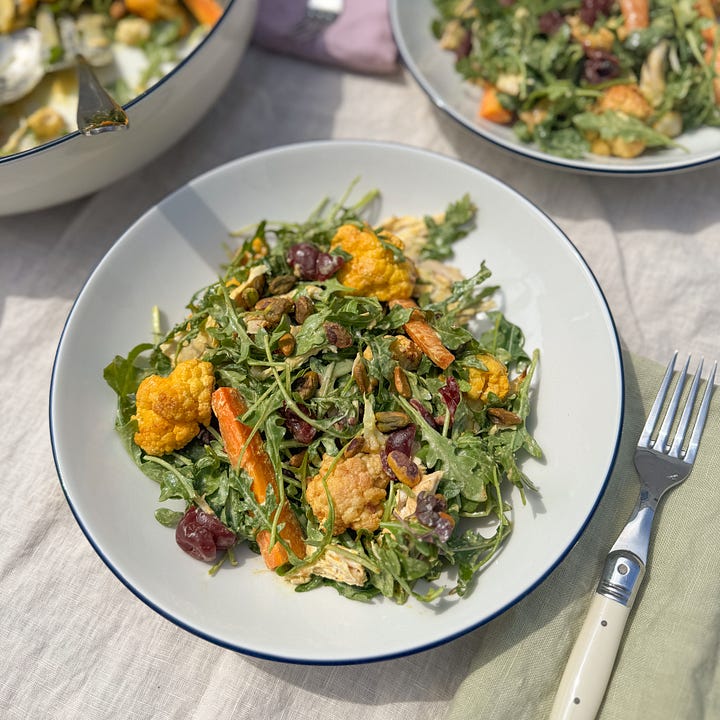
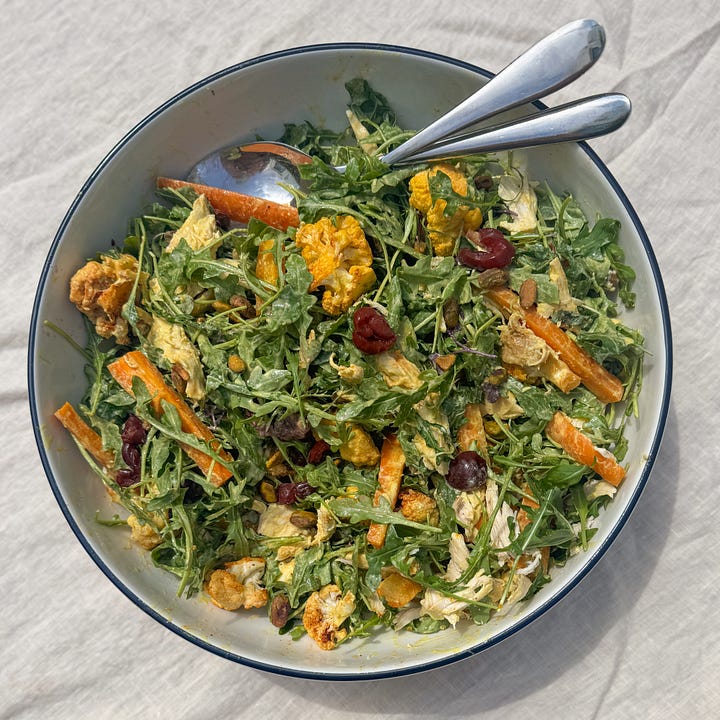
I’m giving out 10 free year-long Color Club memberships this month in honor of the fact the Color Club has just turned 6 months old! 🎂
It’s simple: forward the newsletter to 6 friends or family members (ideally someone you’d want to cook with virtually or in person!) and then shoot me a note and let me know you shared it with 6 friends and I’ll set you up with a free year. 💚
RECIPE LINK HERE
If you make this recipe (or ANY of my recipes!) PLEASE share feedback with me!! Comment below or on the recipe in the Color Club, and if you are on IG, tag me @sonjakmanning.
Lastly, if you heart or re-stack this post or share it with a friend, you’ll help me and these colorful recipes reach more people! 🙏🏼
Chefs kisses,
Sonja









Hi Sonja - I loved this article. I am going to do several of the things you suggested in my community. I shared it with 7 friends. Hopefully they will be inspired to make an impact where they live!
Hey Sonja! Love the idea of pickling fruit! I did forward this email to friends, but not the first time ;) Hope they subscribe!